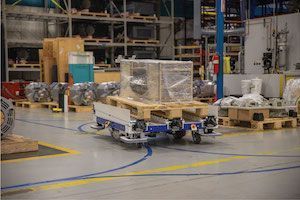
While the Covid-19 outbreak almost destroyed industries like hospitality, retail, transport, and storage — some other markets thrived. One of those is definitely the Automated Guided Vehicle (AGV) Market.
According to Technavio’s latest market research published by Business Wire, the automated guided vehicle (AGV) software market is expected to grow by USD 441.46 million in the 2020-2024 period.
Before Covid-19, AGV market growth was driven by demand for automation of material handling in industries, and the change from mass production to mass customization.
The report by Frost and Sullivan indicates that the pandemic triggered AGV demand. According to their analysis, the automated guided vehicles (AGV) segment is forecast to hit $4.6 billion, while the autonomous mobile robot (AMR) segment is expected to reach $6.8 billion by 2025.
It further shows that the global warehouse industry is experiencing a rapid transformation into autonomous and automated robotic solutions.
Why AGVs Gain Vast Traction During Covid-19
Across the globe, partial and total lockdowns were inflicted due to the pandemic. Various industries experienced shortfalls in productivity which caused big losses. This led to staff layoffs that further suppressed operations.
The deployment of AGVs has become the way to overcome these troubles during these unpredictable times.
In the health industry, AGVs were developed to handle the Covid-19 situation. For instance, in October 2020, a group of students in India developed an AGV for the Karnataka Institute of Medical Sciences Covid-19 hospital block. This AGV was to fulfill the demand for non-contact food deliveries.
According to research conducted by Grand View Research in 2020, 40% of AGVs market revenue came from the warehousing and logistics segment. Enterprises in this sector were using AGVs to boost operation efficiency — and to match the growing demand for their services.
Logistics and warehousing firms were opting for compact layouts, taller racks, and narrow aisles within their facilities. AGVs would help them to maneuver with flexibility inside these distribution spaces.
In the same year, the manufacturing sector contributed 75% of the AGV market revenue. Its adoption of automated guided vehicles was primarily due to natural human errors while moving heavy parts through narrow paths.
Thus, AGVs help them to avoid errors and move freely.
The hardware sector also registered growth in the deployment of collaborative robots. Firms in this segment aim to reduce human labor and repetitive duties in manufacturing and distribution facilities. According to the ReportLinker research, the global market for Automated Guided Vehicle was estimated at US$2.2 Billion in the year 2020 and is projected to reach a revised size of US$3.5 Billion by 2027, growing at a CAGR of 6.8% during the 2020-2027 analysis period.
Benefits that Drive AGV Demand
- Improved Efficiency and Productivity
AGVs perform as programmed. They take less time to perform a task, unlike using human labor. A good example is inventory tracking — a growing challenge in production facilities with high volumes. By integrating AGV with a Warehouse Management System (WMS), you streamline inventory and material handling.
What’s more, these vehicles are loaded with cameras, sensors, and lasers, meaning they can navigate around safely avoiding collisions. This feature helps to reduce operational downtime.
- Controlled Costs
AGVs can operate 24/7 and in low light and low temperatures – factories can reduce utility costs such as electricity.
Additionally, they reduce costs associated with labor, errors, and wastage. Such costs include:
- Recruitment and training costs
- Direct and indirect labor costs
- Payroll taxes
- Employee benefits
- Reduced Work Space
AGVs reduce human material handlers, eliminating the need for more office space. They are a replacement for heavy-duty equipment such as forklifts. Factories and warehouses can therefore use less space than before.
Moreover, AGV sizes suit floor setups with narrower aisles. That’s better space usage. It not only saves costs but also supports scalability.
- Enhanced Safety
The inbuilt sensors in AGVs help to avoid collisions. And it’s a safety mechanism that doesn’t rely on human input, so it won’t be compromised in any way.
Therefore, warehouses experience reduced delivery errors while streamlining inventory management, injuries, and accidents.
AGVs also boost supply chain security. When more suppliers and distributors adopt them, the entire chain stands more robust.
- Non-contact Movement and Storage
With the effects of Covid-19 still ongoing, AGVs are the solution that ensures touchless movement.
While regulatory agencies continue to guard against contamination of food supplies, the distribution centers can use AGVs to limit virus exposure.
Wrap up
Industrial automation using AGVs is the way to meet production demand and sustain economic growth.
AGVs are a replacement for manual carts, conveyor systems, and forklifts. Oftentimes, these machines transport raw materials from receiving points to warehouses or production lines. There are many types of AGVs you can use in your facility: towing vehicles, Autonomous Mobile Robots, heavy burden carriers, unit load carriers, and forklift vehicles to name a few.
As collaborations, acquisitions, and mergers increase to enhance overall AGVs benefits, companies should get ready to adopt this factory and warehousing solution.
Business owners will not only gain internal benefits but a global competitive advantage as well.
Luke Goodwin is an experienced content marketing manager with a demonstrated history of working in the logistics and supply chain industry. Currently, he works at FlexQube where he creates valuable content relevant to the intralogistics and material handling industries. To learn more about FlexQube and see more articles from the industry you can visit their news website.









 The 2024 virtual Men’s Round Table will be held Q4, 2024, date TBD.
The 2024 virtual Men’s Round Table will be held Q4, 2024, date TBD.












